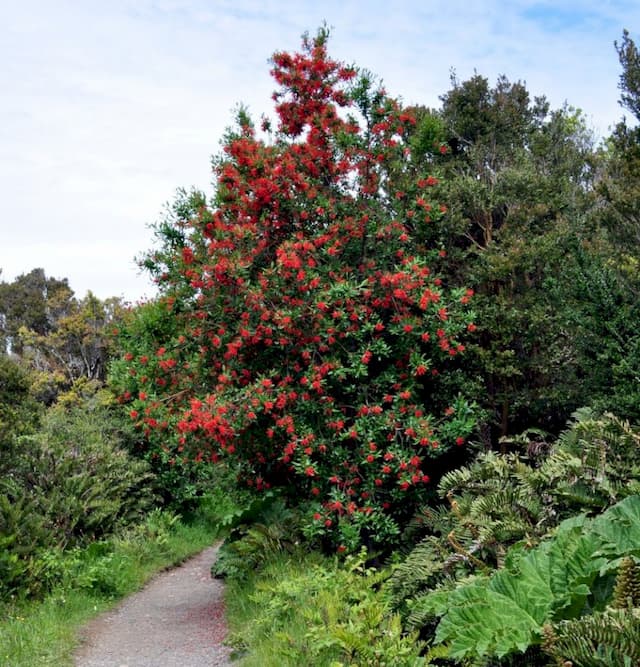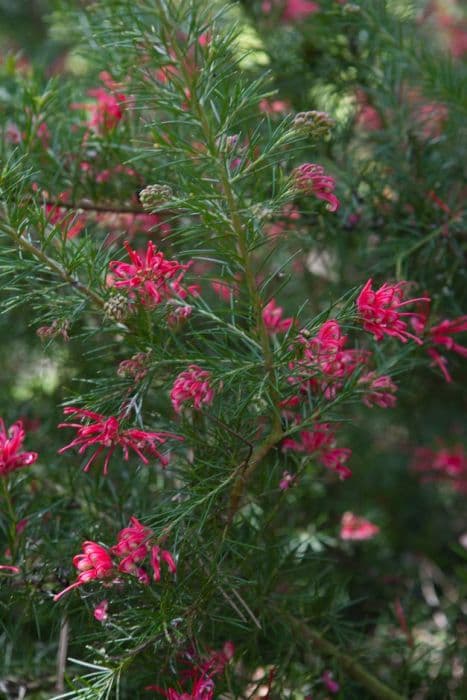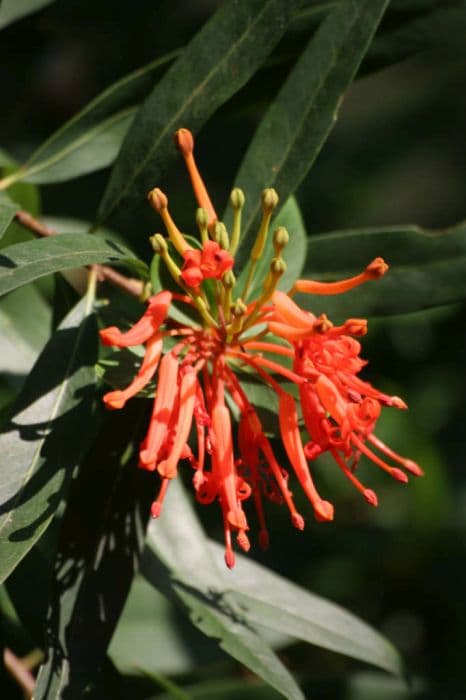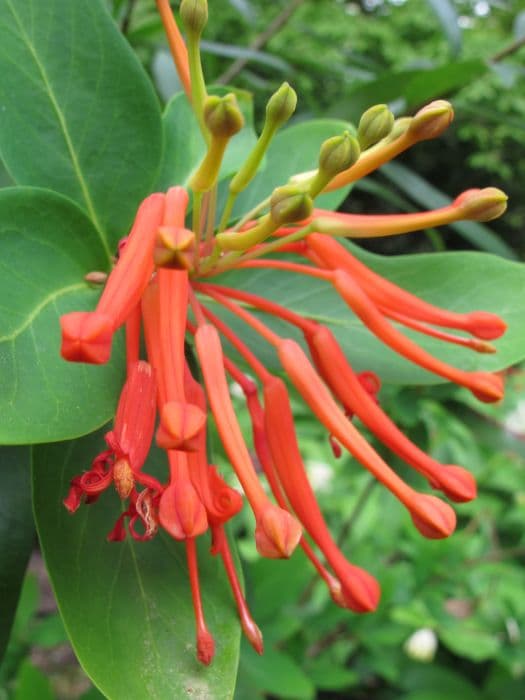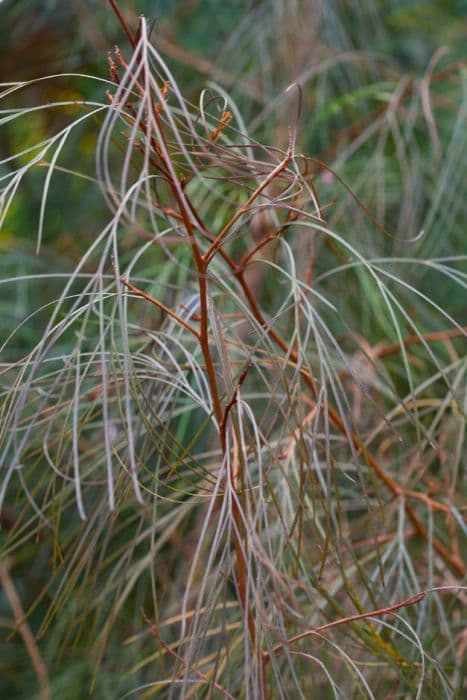Rosemary Grevillea Grevillea rosmarinifolia 'Jenkinsii'

ABOUT
Grevillea rosmarinifolia 'Jenkinsii', commonly known as Rosemary Grevillea, is an attractive evergreen shrub that is valued for both its foliage and its blooms. The plant bears a striking resemblance to the herb rosemary, which is how it gets its common name; the leaves are needle-like and deep green, offering a fine texture and aroma when brushed or crushed. These leaves are typically arranged in a dense and linear fashion along the stems, giving the plant a somewhat tidy and compact look. The Rosemary Grevillea flowers are no less remarkable. They display a vibrant, eye-catching hue of red, with a unique, almost spider-like form. The flowers are composed of long, protruding stamens, which makes them quite distinct and particularly attractive to birds and other pollinators. These blooms often appear in clusters at the terminals of the branches, contributing a splash of color that can be especially appreciated during the blossoming season. Furthermore, the overall structure of the plant with its arching branches presents a graceful appearance in the landscape, allowing it to be used for various gardening applications. Whether used as an ornamental feature, a hedge, or a part of a mixed border, Rosemary Grevillea adds a touch of elegance and a natural allure that is hard to overlook. Its adaptability and decorative qualities make it a beloved choice for gardeners looking to introduce a resilient and beautiful plant to their outdoor spaces.
About this plant
 Names
NamesSynonyms
Rosemary Grevillea, Rosemary-leaf Grevillea, Jenkinsii Grevillea.
Common names
Grevillea rosmarinifolia 'Jenkinsii'.
 Toxicity
ToxicityTo humans
The Rosemary Grevillea generally is not considered highly toxic to humans; however, like many plants in the Grevillea genus, it can cause skin irritation or allergic reactions in some individuals due to the presence of compounds like proteolytic enzymes. If ingested, the plant may cause mild gastrointestinal upset, though it is not commonly reported as a poisonous plant for humans. Nonetheless, any part of the plant should not be consumed, and it is advised to handle the plant with care, especially if you have sensitive skin or known allergies.
To pets
Similar to its effects on humans, the Rosemary Grevillea is not widely reported as highly toxic to pets. However, pets may experience mild gastrointestinal discomfort if they ingest parts of this plant. They may also suffer from skin irritation if they come into contact with the plant's foliage or flowers, especially if they have sensitive skin or a predisposition to allergies. To prevent any potential discomfort or adverse effects, it's recommended to discourage pets from chewing on or otherwise ingesting any parts of the plant.
 Characteristics
CharacteristicsLife cycle
Perennials
Foliage type
Evergreen
Color of leaves
Green
Flower color
Red
Height
3-5 feet (0.9-1.5 meters)
Spread
3-5 feet (0.9-1.5 meters)
Plant type
Shrub
Hardiness zones
9
Native area
Australia
Benefits
 General Benefits
General Benefits- Attracts Wildlife: The plant produces nectar-rich blossoms that attract birds and insects, especially beneficial pollinators like bees.
- Drought Tolerance: Grevillea rosmarinifolia 'Jenkinsii', also known as Rosemary Grevillea, is highly drought-tolerant once established, making it ideal for water-wise gardens.
- Low Maintenance: This plant has minimal need for pruning, fertilizer, and is resilient to many pests and diseases, reducing the need for chemical treatments.
- Year-Round Interest: The Rosemary Grevillea offers ornamental appeal throughout the year with its evergreen foliage and regular flowering cycles.
- Erosion Control: Its extensive root system can help stabilize soil and prevent erosion on slopes or in areas prone to soil degradation.
- Landscape Versatility: It can be used in a variety of landscape situations, including as a hedge, screen, specimen plant or part of a mixed shrubbery border.
- Rapid Growth: Rosemary Grevillea is known for its relatively quick growth rate, allowing for faster establishment and landscape impact.
 Medical Properties
Medical PropertiesThis plant is not used for medical purposes.
 Air-purifying Qualities
Air-purifying QualitiesThis plant is not specifically known for air purifying qualities.
 Other Uses
Other Uses- Garden Sculpture: Grevillea rosmarinifolia can be pruned and trained to create living sculptures in the garden, providing a unique artistic element.
- Educational Tool: The intricate flowers can be used to teach students or gardening enthusiasts about plant biology and pollination mechanisms.
- Cultural Symbol: In some cultures, the Grevillea can represent resilience or adaptability and thus be used in ceremonies or as a symbol in gardens.
- Photography Subject: The striking flowers and foliage of the Grevillea make it a popular subject for botanical photographers and artists.
- Street Tree: Due to its size and the fact that it's evergreen, it can be used as a street tree in residential areas for year-round greenery.
- Windbreaks: Dense hedges of Grevillea can be used as windbreaks to protect against soil erosion in exposed areas.
- Noise Reduction: Planted en masse, these shrubs can help reduce noise levels, acting as a living sound barrier in suburban gardens.
- Privacy Screen: The thick foliage provides an excellent privacy screen, creating secluded spaces within gardens or along property lines.
- Theme Gardens: Grevillea can be included in Australian native gardens or Mediterranean-themed landscapes as an example of appropriate flora.
- Erosion Control: Their extensive root systems help stabilize the soil in sloped gardens, preventing erosion during heavy rains.
Interesting Facts
 Feng Shui
Feng ShuiThe Rosemary Grevillea is not used in Feng Shui practice.
 Zodiac Sign Compitability
Zodiac Sign CompitabilityThe Rosemary Grevillea is not used in astrology practice.
 Plant Symbolism
Plant Symbolism- Resilience: Grevillea rosmarinifolia 'Jenkinsii', also known as Rosemary Grevillea, is known for its hardiness and ability to thrive in tough environmental conditions, symbolizing the ability to endure and persist through challenges.
- Protection: In some cultures, grevilleas are considered protective plants. Their spiky foliage can be associated with a protective barrier, representing safety and shelter.
- Uniqueness: With its unique and intricate flowers, the Rosemary Grevillea can symbolize the beauty of individuality and the celebration of what makes each person or situation special.
- Adaptability: The plant's ability to adapt to different soil types and climates makes it a symbol of adaptability and flexibility in life's circumstances.
 Water
WaterRosemary Grevillea should be watered deeply approximately once a week during its growing season, allowing the soil to dry out between watering sessions. This encourages the plant to develop a strong root system. During winter, reduce the watering frequency as the plant requires less moisture due to cooler temperatures and potentially reduced light levels. Typically, a mature plant will need about 1 to 1.5 gallons of water for each watering session, depending on the size of the plant and the weather conditions.
 Light
LightRosemary Grevillea thrives in full sun to partial shade. It is best to position the plant in a spot where it will receive at least six hours of sunlight per day. The ideal location is one where the morning sun warms the plant, and it's protected from the harsh afternoon sun, especially in hotter climates to prevent leaf scorch.
 Temperature
TemperatureRosemary Grevillea prefers a temperate climate and can withstand a range of temperatures, but it performs best when the temperature is between 50°F and 85°F. The plant can survive occasional dips as low as 20°F but may suffer damage if exposed to such low temperatures for prolonged periods. Optimal growth and health are maintained when the plant is not subjected to extreme heat above 95°F or severe frost conditions.
 Pruning
PruningRosemary Grevillea benefits from pruning to maintain its shape, encourage bushier growth, and remove any dead or diseased wood. Pruning should be carried out after flowering has finished, usually in late spring or early summer. This plant does not require frequent pruning; once per season is generally enough. Make sure to use clean, sharp tools to make precise cuts and avoid tearing the plant tissue.
 Cleaning
CleaningAs needed
 Soil
SoilThe Rosemary Grevillea prefers well-draining, slightly acidic to neutral soil, with a recommended pH range of 6.0 to 7.0. The ideal soil mix should consist of equal parts sand, peat, and loamy soil with some compost to nourish the plant. Ensure adequate drainage to prevent waterlogging.
 Repotting
RepottingRosemary Grevillea should be repotted every 2-3 years, or when it has outgrown its current pot. Refresh the soil with the recommended mix during the process to promote healthy growth and maintain plant vigor.
 Humidity & Misting
Humidity & MistingRosemary Grevillea thrives in moderate to low humidity conditions. It is well-adapted to the dry air commonly found in home environments and does not require high humidity levels to flourish.
 Suitable locations
Suitable locationsIndoor
Place in bright, indirect light and avoid overwatering.
Outdoor
Plant in a sunny spot, protect from extreme cold and ensure proper drainage.
Hardiness zone
9-11 USDA
 Life cycle
Life cycleGrevillea rosmarinifolia 'Jenkinsii', commonly known as Rosemary Grevillea, begins its life cycle as a seed that requires well-drained soil and full sun exposure for optimal germination. Once sprouted, the seedling gradually develops into a young plant, characterized by needle-like foliage resembling that of rosemary, hence its common name. As it matures, this evergreen shrub enters a vegetative growth phase, forming a dense, bushy shape reaching approximately 1m tall and 1-2m wide. The plant then progresses to its flowering stage, usually in late winter to spring, producing distinctive red flowers that attract birds and pollinators. After pollination, the flowers give way to fruit, which are actually follicles that open to release seeds, completing the reproductive cycle. This plant can live for many years, continuously going through cycles of growth and reproduction.
 Propogation
PropogationPropogation time
Spring to Summer
Propogation: The Rosemary Grevillea, also known by its botanical name Grevillea rosmarinifolia 'Jenkinsii', is commonly propagated through the method of semi-hardwood cuttings. The appropriate time to take cuttings is during the late summer to autumn, when new growth has partially matured but is not fully hardened. To propagate, select healthy, semi-ripe stems and cut sections approximately 4 to 6 inches (10 to 15 centimeters) in length. It's essential to make the cut just below a node, as this is where the highest concentration of rooting hormones is found. Remove the lower leaves and dip the cut end in rooting hormone powder to encourage root growth. Then, insert the cuttings into a well-draining propagation mix, ensuring that at least one node is buried where roots can develop. Keep the soil moist and maintain a humid environment until the cuttings have rooted, which typically takes several weeks.


